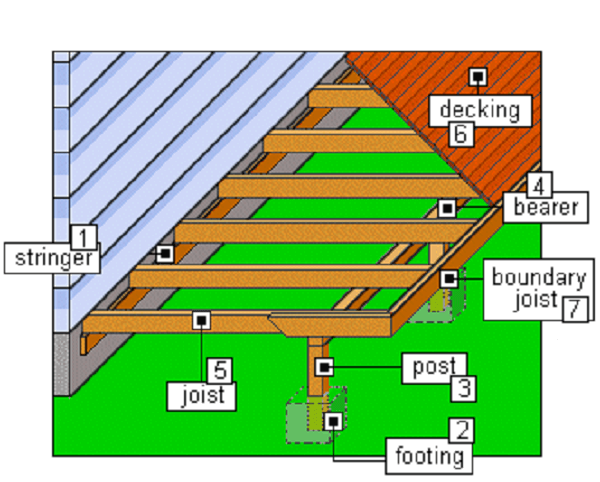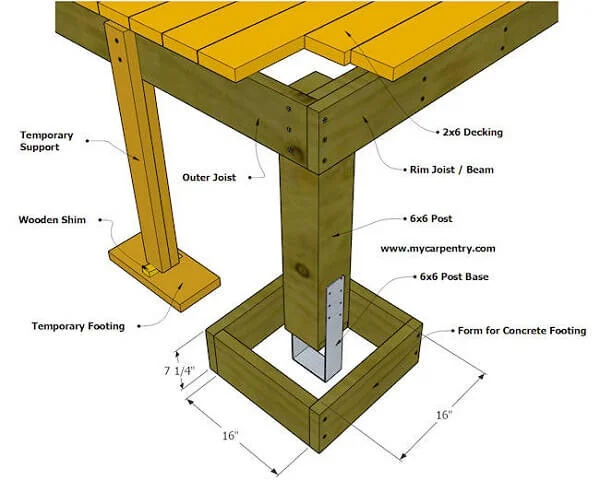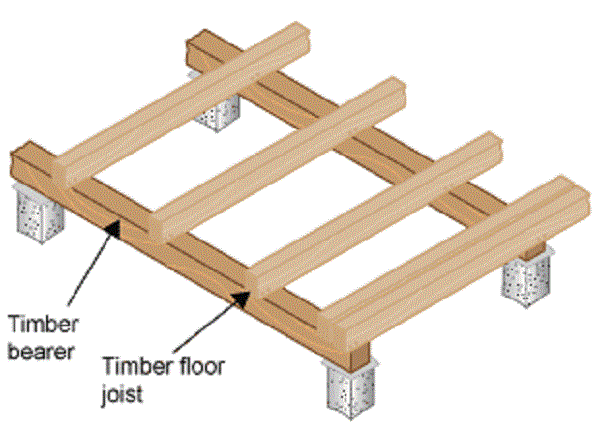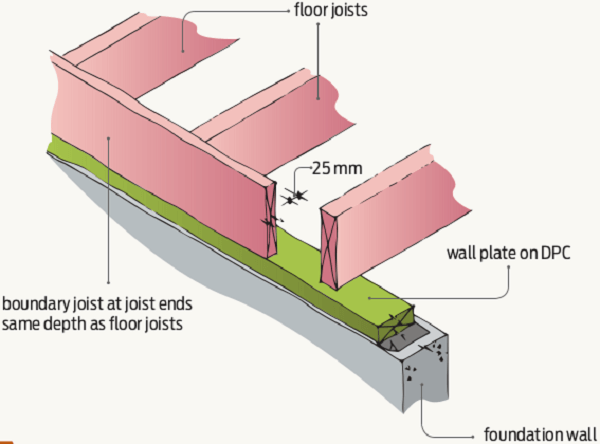Anatomy of a Deck
Today, we offer you to look into details at the anatomy of your future decking! Indeed, it can come as a surprise to future deck owners that such installation requires material beyond its most noticeable part: the decking boards.
A deck also requires the supply of stringers, posts, footings, bearers, joists and more!
Essential Preparations
Before contemplating doing any building work, we strongly recommend you to inquire at your local building store to find out what wood you would need to purchase. All lumber should be suitable for exterior use and any lumber either touching the ground or going into the ground should be suitable for in-ground applications.
We also recommend you to contact your city council to find out what are the requirements bound by local building code and what permits and/or consents may be required.
Most importantly, you need to make sure to choose the right contractor for the project you aim to create. In that regard, we have written a dedicated article on the topic.
Since knowledge about materials is recommended, let’s look at the anatomy of a decking.
Deck Terminology and Components
Understanding deck terminology and components is essential for anyone planning to build or maintain a deck. Here are some key terms and components:
Decking: The surface boards that make up the floor of the deck. These can be made from various materials, including wood and composite materials.
Stringers: Also known as ledger plates, these are pieces of lumber bolted to the house to support the joists. Proper spacing and installation are crucial to prevent moisture trapping.
Footings: Concrete bases that support the deck's posts. They need to be deep enough to avoid frost heave and wide enough to distribute the load.
Posts: Vertical supports that hold up the deck. Typically made from sturdy lumber like 4x4s or 6x6s, their spacing depends on the deck’s design.
Bearers: Horizontal beams that transfer the load from the joists to the posts. The size and spacing of bearers are determined by the span and load they need to support.
Joists: Horizontal supports that run between the bearers and support the decking. They can be attached to the stringers using joist hangers or by sitting on top of the ledger plate.
Railings: Safety barriers installed around the perimeter of the deck. They consist of posts, balusters, and a top rail.
Stairs: Provide access to the deck from the ground or other levels. Proper design and construction are critical for safety.
1) Stringers
Also called a ledger plate. The stringer is the piece of lumber bolted to the house upon which the joists are fixed on or to. The stringer needs to be packed out from the building at every bolt fixing to prevent moisture being trapped between the stringer and the building.
The spacing between the bolts depends on the size of the stringer and the span of the joists which are fixed on or to it. Example: If a stringer is 100x50 (2x4) in size and if the joists fixed to that stringer span 2m (80”), the bolts that attach the stringer to the building should be 1.25m (50”) apart, whereas if the joists span 6m (20ft), the bolts should be 0.5m (20”) apart.
2) Footings
A standard footing hole size for 100x100 (4x4) or 125x125 (5x5) post is 300mm x 300mm
(12x12) square and 450mm (18”) deep in firm ground. In soft ground the holes will need to be bigger and deeper. Also holes will need to be deeper in”frost”; areas. 100mm (4”) of concrete is required as a pad beneath the post.
3) Posts
Posts are Usually at least 100x100 (4x4). The spacing of posts along the bearer line depends on the structure of the deck.
4) Bearers
The size of the bearer depends on the length of the joists and the span of the bearer.
5) Joists
The joists are fixed to the stringer either by butting up to and fixing with joist hangers, or by sitting on top of the ledger plate and nailing through both faces of the joist.
The joists sit on top of the bearer (see above picture), and are fixed by way of nailing through each face of the joist into the bearer.
The size of the joists depend on the joist span and the joist spacing. Such an important topic has been explained in a previous article.
6) Decking
The thickness and strength of the various deck materials determines how far apart the joists must be. You will of course need to decide which wood to choose beforehand.
7) Boundary joist
The boundary joist is fixed to the perimeter of the deck to give a neat finish. In most cases the boundary joist is decorative rather than structural, therefore another preference might be to replace the boundary joists with decking boards.
Additional Considerations:
Selecting the Right Contractors: Ensure your contractor is experienced and reputable. Check references and previous work.
Fire Safety Ratings: Understand ratings like flame spread and ignition resistance to choose materials that enhance safety.
Seasonal Maintenance Tips: Regularly inspect and maintain your deck to prevent issues like rot. Clean and seal the wood as needed.
Common Issues: Be aware of potential problems such as deck rot, which can be prevented with proper maintenance and material choices.
What type of resources are available to help me build my deck?
Various resources can aid you in building your deck. You can find comprehensive guides and tutorials online, including step-by-step videos and detailed articles. Local building stores often offer free advice and may even provide instructional workshops. Books on deck construction are another excellent resource, offering in-depth information and illustrations.
Once again, we cannot say enough how much “knowledge is power” when it comes to building anything, and of course a new deck. Thus, do not hesitate to get a book, read other articles about anatomy of a deck, or ask your personal network for personal experiences!
Where can I find easy-to-follow tips for my deck building project?
Easy-to-follow tips for your deck building project can be found on DIY websites, home improvement blogs, and YouTube channels dedicated to home construction and renovation. Additionally, many hardware stores and lumber suppliers offer printed guides and online resources tailored to help you with your decking project.
Last but not least, we are always happy to help everyone, no matter if you order your decking with us or not.





